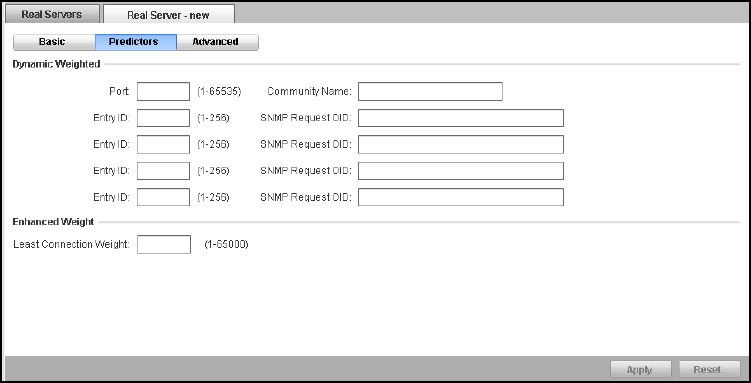(Supporting ADX v03.1.00) Owner's manual
Table Of Contents
- Contents
- Preface
- Introduction to the Brocade Virtual ADX Web Interface
- Navigating the Web Interface
- Navigating the Dashboard
- Configuration Overview
- System Settings
- Network Settings
- Traffic Settings
- GSLB Settings
- Security Settings
- Monitoring Overview
- Viewing System Information
- Viewing Network Status
- Viewing Traffic Statistics
- Viewing Security Statistics
- Maintenance Overview
- Managing Software Images
- Restarting the System
- License Management
- Packet Capture
- Accessing the CLI
- Retrieving System Information for Technical Support
- Troubleshooting
- Config Template XML Schema
- Managing Config Templates through the CLI

80 Brocade Virtual ADX Graphical User Interface Guide
53-1003242-01
Real servers
7
• Backup: Select the Enable check box to designate the real server to be a backup server if
all the primary servers are unavailable for the requested application.
• Use Learned MAC Address: Select the Enable check box to enable MAC Address learning
on the real server.
5. Click Apply to save your entries.
Click Reset to revert the configuration to the previous configured values.
To modify the configured real server information, in the summary table, select an entry and
click Edit or double-click the entry. Click Delete to delete a real server configuration.
For more information on configuring real servers, refer to the Brocade Virtual ADX Server Load
Balancing Guide.
Setting predictors and advanced settings for real servers
To configure predictors for real servers on the Brocade Virtual ADX, perform the following steps
within the Configure tab.
1. Click Traffic on the menu bar.
2. From the sidebar, select Real Servers.
3. Click New at the bottom of the Real Servers page.
4. Click the Predictors tab.
The Predictors tab is displayed, as shown in Figure 66.
FIGURE 66 Configuring predictors parameters
5. Under Dynamic Weighted, enter the following information:
• Port: Enter the SNMP request host port.
• Community Name: Enter an SNMP community name to restrict SNMP access to all the real
servers.
• Entry ID: Enter the SNMP request entry identification in the fields and the corresponding
SNMP Object ID (OID) value in the SNMP Request OID fields.










